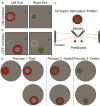On the functional order of binocular rivalry and blind spot filling-in
- PMID: 28502775
- PMCID: PMC5507553
- DOI: 10.1016/j.visres.2017.04.009
On the functional order of binocular rivalry and blind spot filling-in
Abstract
Binocular rivalry is an important phenomenon for understanding the mechanisms of visual awareness. Here we assessed the functional locus of binocular rivalry relative to blind spot filling-in, which is thought to transpire in V1, thus providing a reference point for assessing the locus of rivalry. We conducted two experiments to explore the functional order of binocular rivalry and blind spot filling-in. Experiment 1 examined if the information filled-in at the blind spot can engage in rivalry with a physical stimulus at the corresponding location in the fellow eye. Participants' perceptual reports showed no difference between this condition and a condition where filling-in was precluded by presenting the same stimuli away from the blind spot, suggesting that the rivalry process is not influenced by any filling-in that might occur. In Experiment 2, we presented the fellow eye's stimulus directly in rivalry with the 'inducer' stimulus that surrounds the blind spot, and compared it with two control conditions away from the blind spot: one involving a ring physically identical to the inducer, and one involving a disc that resembled the filled-in percept. Perceptual reports in the blind spot condition resembled those in the 'ring' condition, more than those in the latter, 'disc' condition, indicating that a perceptually suppressed inducer does not engender filling-in. Thus, our behavioral data suggest binocular rivalry functionally precedes blind spot filling-in. We conjecture that the neural substrate of binocular rivalry suppression includes processing stages at or before V1.
Keywords: Binocular rivalry; Blind spot; Filling-in; Visual awareness.
Copyright © 2017 Elsevier Ltd. All rights reserved.
Figures




Similar articles
-
Filling-in at the natural blind spot contributes to binocular rivalry.Vision Res. 2001 Mar;41(7):835-40. doi: 10.1016/s0042-6989(00)00315-1. Vision Res. 2001. PMID: 11248269
-
Characteristics of the filled-in surface at the blind spot.Vision Res. 2012 Apr;58:33-44. doi: 10.1016/j.visres.2012.01.020. Epub 2012 Feb 28. Vision Res. 2012. PMID: 22402231
-
Interocular rivalry revealed in the human cortical blind-spot representation.Nature. 2001 May 10;411(6834):195-9. doi: 10.1038/35075583. Nature. 2001. PMID: 11346796
-
How does binocular rivalry emerge from cortical mechanisms of 3-D vision?Vision Res. 2008 Sep;48(21):2232-50. doi: 10.1016/j.visres.2008.06.024. Epub 2008 Aug 13. Vision Res. 2008. PMID: 18640145 Review.
-
Neural responses in the primary visual cortex of the monkey during perceptual filling-in at the blind spot.Neurosci Res. 2002 Nov;44(3):231-6. doi: 10.1016/s0168-0102(02)00149-9. Neurosci Res. 2002. PMID: 12413651 Review.
Cited by
-
Did you see it? A Python tool for psychophysical assessment of the human blind spot.PLoS One. 2021 Nov 4;16(11):e0254195. doi: 10.1371/journal.pone.0254195. eCollection 2021. PLoS One. 2021. PMID: 34735455 Free PMC article.
-
Inflation versus filling-in: why we feel we see more than we actually do in peripheral vision.Philos Trans R Soc Lond B Biol Sci. 2018 Sep 19;373(1755):20170345. doi: 10.1098/rstb.2017.0345. Philos Trans R Soc Lond B Biol Sci. 2018. PMID: 30061459 Free PMC article.
References
-
- Awater H, Kerlin JR, Evans KK, Tong F. Cortical Representation of Space Around the Blind Spot. Journal of Neurophysiology. 2005;94(5):3314–3324. https://doi.org/10.1152/jn.01330.2004. - DOI - PMC - PubMed
-
- Baek Y, Cha O, Chong SC. Characteristics of the filled-in surface at the blind spot. Vision Research. 2012;58:33–44. https://doi.org/10.1016/j.visres.2012.01.020. - DOI - PubMed
-
- Blake R. A neural theory of binocular rivalry. Psychological Review. 1989;96(1):145–167. https://doi.org/10.1037/0033-295X.96.1.145. - DOI - PubMed
-
- Blake R, Logothetis NK. VISUAL COMPETITION. Nature Reviews Neuroscience. 2002;3(1):13–21. https://doi.org/10.1038/nrn701. - DOI - PubMed
Publication types
MeSH terms
Grants and funding
LinkOut - more resources
Full Text Sources
Other Literature Sources

